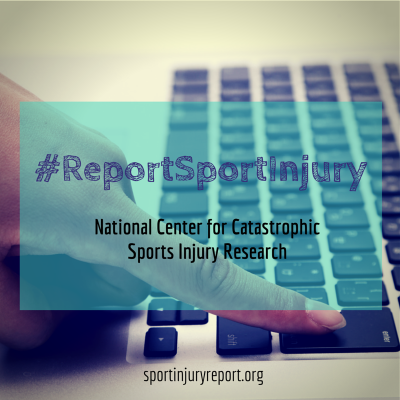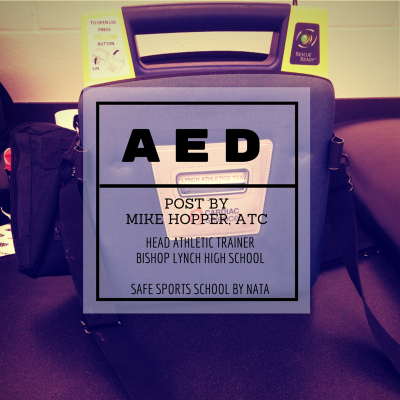The Korey Stringer Institute is proud to announce the winners of the 2015 Lifesaving Awards. In 2012, the Korey Stringer Institute started recognizing three individuals annually who have made significant contributions in the realm of preventing sudden death in sport. These individuals are leaders in their fields when it comes to making important policy changes to prevent sudden death in sport. The three annual awards are the Lifesaving Research Award, Lifesaving Service Award and the Lifesaving Education Award. Each award recognizes excellence in a given aspect of the Korey Stringer Institute’s mission of preventing sudden death in sport.
Lifesaving Research Award
This award recognizes exceptional dedication and work in research aimed to improve knowledge regarding preventing sudden death in sport.
 Erik Swartz, PhD, ATC, FNATA
Erik Swartz, PhD, ATC, FNATA
Professor and Department Chair, Kinesiology
University of New Hampshire
Erik E Swartz PhD, ATC, FNATA, Professor and Chair, Department of Kinesiology at the University of New Hampshire. Dr. Swartz received his PhD in Applied Biomechanics at the University of Toledo. Dr. Swartz’ primary research interest focuses on the prevention and care of head and neck injuries in football. Dr. Swartz has received grants from The NATA Foundation, NOCSAE, NFL Charities, and was recently a named a winner of the NineSigma Head Health Challenge II. He has been published in journals such as The American Journal of Emergency Medicine, New England Journal of Medicine, Spine, and The American Journal of Sports Medicine. He serves on the NFL Head Neck and Spine Committee’s Subcommittee on Safety Equipment and on the Editorial Boards of the Journal of Athletic Training and Athletic Training and Sports Health Care Journal. Dr. Swartz served as chair of the NATA Position Statement on the Acute Management of the Cervical Spine Injured Athlete. In 2011 he was honored with a Fellows designation in the National Athletic Trainers’ Association and in 2015 received the Most Distinguished Athletic Trainer Award, also from the NATA. He and his wife Renee have two children, Evry and Caleb.
Lifesaving Service Award
This award recognizes exceptional service aimed to improve policies and advocate for the adoption of policies in order to reduce sudden death in sport.
 John Jardine, MD
John Jardine, MD
Chief Medical Advisor & Chairman of the Medical & Science Advisory Board, KSI
Attending Physician, Landmark Medical Center
Medical Director, Falmouth Road Race
John Jardine, MD, is a board certified emergency medicine physician since 2000. His interest in race medicine was piqued when he first volunteered at the Falmouth Road Race in the summer of 2000. Two years later, he was appointed co-medical director of the race and has been directing medical operations since. As co-director, he is involved with the overall coordination of the medical care at the race including the recruitment and training of volunteers, ensuring adequate supplies and equipment are available for medical services, and providing emergency care to the athletes, spectators, and volunteers involved with the race. Through the history of the race, the medical team has developed protocols for the treatment of exertional heat illness. Dr. Jardine has continued to perfect these protocols and has teamed with KSI to continue research to protect athletes worldwide. He has co-authored two research papers, “The Effectiveness of Cold Water Immersion in the Treatment of Exertional Heat Stroke at the Falmouth Road Race”, and “Relationship Between Aerobic Fitness Parameters, Body Temperature, and Perceptual Responses Following a Warm-Weather Road Race” through his experience with medical care at the race. Dr. Jardine has been involved in medical care at long distance races. As an invited guest, he has assisted the medical team at the Boston Marathon in the critical care and heat illness treatment areas. Dr. Jardine’s start in medicine was in Emergency Medical Services (EMS) as an EMT and then Paramedic in New York State. After 12 years of practicing prehospital medicine, Dr. Jardine earned his medical degree at Downstate Medical School in Brooklyn, New York. He completed residency in emergency medicine at Rhode Island Hospital/Brown University serving as chief resident in his senior year. His background in EMS has provided experience in disaster medicine and mass casualty incidents (MCIs). He worked with the Rhode Island Disaster Medical Assistance Team (DMAT) to staff field hospitals at mass gatherings. With RI DMAT, Dr. Jardine implemented and staffed a mobile hospital to provide medical support to the offshore Egypt Air Flight 990 recovery mission. As an emergency physician, Dr. Jardine directed the medical care for Operation Helping Hand, Massachusetts Governor Romney’s temporary relocation of the displaced victims of Hurricaine Katrina to Camp Edwards on Cape Cod. The organizational and administrative skills previously experienced with MCIs have been invaluable in coordinating medical care for events involving several thousand athletes.
 Robert J. Davis, MD
Robert J. Davis, MD
Diplomat, American Board of Emergency Medicine
Medical Director, Emergency Department at Falmouth Hospital
Robert J. Davis, MD, has nearly 20 years of experience as an emergency medicine physician and has been a leader in the development of exertional heat stroke treatment protocol through his 13 years as Co-medical Director of the New Balance Falmouth Road Race, an elite running event held each August in Falmouth, MA. As co-medical director of the New Balance Falmouth Road Race since 2002, Dr. Davis and his team of volunteer medical personnel from the Falmouth Hospital Emergency Department staff three medical tents along the race route. Due to the numbers and severity of exertional heat stroke patients the Falmouth Road Race medical team sees over the course of the 7-mile course, they are trained and experienced in effective treatment methods. The medical team has been providing medical care at the race for the last 40 years, and their development of treatment methods for exertional heat stroke over the years – including immediate immersion in ice baths on the race course – helped establish the treatment protocol still in use today. Over the years, Dr. Davis and his team have used their skills and experience to save many lives and help hundreds of runners recover quickly and resume their normal activities. Dr. Davis is Medical Director of the Emergency Department at Falmouth Hospital in Falmouth, MA, and is also Medical Director of the Urgent Care Department at Stoneman Outpatient Center in Sandwich, MA. He earned his medical degree at Boston University School of Medicine in 1995 and completed an internship and residency at Rhode Island Hospital in Providence, RI. He was chief resident at Rhode Island Hospital and assistant clinical instructor of medicine at Brown University School of Medicine from 1998-1999. Dr. Davis is a diplomat of the American Board of Emergency Medicine. He directs a bi-monthly Morbidity and Mortality Conference on Risk Management in the Falmouth Hospital Emergency Department, and is a consulting expert in emergency medicine. He is on the board of directors of Cape Cod Health Network, a physician-hospital organization, and is also on the board of the Cape Cod Health Network ACO. He also serves on the Quality Committee of the Physicians of Cape Cod, a private physicians group.Dr. Davis has won numerous medical awards, including the Daniel L. Savitt Resident Teaching Award and the Gregory D. Jay Resident Research Award from Rhode Island Hospital in 1999, the Certificate of Appreciation for Outstanding Performance in Pediatric Emergency Medicine from Hasbro Children’s Hospital in 1999, the Alpha Omega Alpha distinction at Boston University School of Medicine in 1995, and the Falmouth Hospital Trauma Award in 2006.
Lifesaving Education Award
This award recognizes exceptional work aimed to improve knowledge and education in the realm of preventing sudden death in sport.
 Lisa Walker, ATC
Lisa Walker, ATC
Athletic Trainer, Springville High School
Lisa Walker, a native of Orange County, Calif., began her athletic training career in 1993 when she graduated from Brigham Young University in Provo, Utah. She has worked as the head athletic trainer at Springville (Utah) High School ever since. Lisa has held numerous positions within the Utah Athletic Trainers’ Association, the Rocky Mountain Athletic Trainers’ Association, and the National Athletic Trainers Association. She has provided service with the Red Cross of America, the Australia Down Under Bowl (American football) in 2000 and the 2002 Winter Olympics in Salt Lake City, as well as other local events and organizations. Lisa was the secretary/treasurer of the Utah Athletic Trainers’ Association from 1998-2002, president of the UATA from 2002-2007, president of the Rocky Mountain Athletic Trainer’s Association from 2007-2012, and she continues to serve on the UATA board of directors, the Sports Medicine Advisory Council of the Utah High School Activities Association, the NATA Secondary Schools Committee and Honors and Awards Committee, and the Strategic Planning Committee to prevent sudden death in secondary school athletes. During her time with the UATA, she helped produce “Advocates of the Student Athlete,” an NATA award-winning video in 2000. She was instrumental in passing a law mandating licensure for all athletic trainers in the state of Utah and helped champion concussion legislation. She helped athletic trainers gain recognition as official healthcare providers, passed mandatory heat acclimatization for all athletes, pre-participation exams and concussion policies with the Utah High School Activities Association, as well as mandatory CPR and first aid certification for all Utah coaches and a thorough weight management system for all high school wrestlers. Lisa was named to the RMATA Hall of Fame in 2014, the public advocacy award winner by the Board of Certification in 2013, NATA Athletic Trainer Service Award in 2013, NATA Governmental Affairs award in 2006 and several other honors within the UATA, RMATA and other local organizations. Lisa resides in Provo, Utah, where she continues her work as a high school teacher and athletic trainer and serves as a clinical instructor for athletic training students at Brigham Young University while championing for athletic training reform with the Utah state legislature. Lisa continues to promote safety for the physically active of all ages. Her and her husband, David, are the parents of three children.



